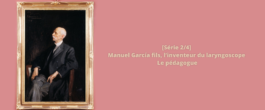


20 august 2023
By highlighting the story of Manuel García fils (1805-1906), the Centre Européen de Musique is paying tribute to a polymath, teacher, singer, scientist and researcher, a member of a unique family saga: the García dynasty. The invention of the laryngoscope by Manuel García Jr. in 1854 was no accident, and the acquisition by the Centre Européen de Musique of this priceless relic is a powerful symbol that fully embodies the missions that the CEM has set itself in the 21st century: building bridges between the present and the past; uniting the arts, sciences and humanities. After a first episode devoted to Manuel's youth, discover the second episode of our historical series, written by Thomas Cousin, Doctoral Candidate in History and Musicology at the Université Libre de Bruxelles/Sorbonne University.

On his return from Naples, Manuel García fils studied astronomy and navigation with a view to joining the French merchant navy as an officer. He took part in the Algerian expedition and embarked in Toulon on 11 May 1830, alongside tens of thousands of men. He witnessed the bombardment of Algiers and its surrender. Back in Paris, he witnessed the July revolutionary days, the fall of King Charles X, and then the advent of the July Monarchy and its King Louis-Philippe d'Orléans. Enlisted as a military doctor in the Paris hospitals, he specialised in the study of the anatomy and physiology of the larynx, already aware of the relationship between science and the development of the voice. When his father died in 1832, Manuel García Jr. carried with him an immense musical legacy that he intended to perpetuate while applying his new scientific knowledge of medicine to the art of singing. Appointed singing teacher at the Paris Conservatoire in 1835, he embarked on a career as a teacher that he would never abandon, finding in the transmission of his art the vocation of a lifetime.
In the preface to his singing method École de García, Traité complet de l'art du chant, published in 1840, Manuel García Jr. lays claim to his father's precepts: "It is his method that I have sought to reproduce, attempting only to reduce it to a more theoretical form, and to relate the results to the causes". This teaching method is based on an enlightened knowledge of how the vocal apparatus works, described succinctly in the first few pages of the work. The Treatise also includes important passages from the Memoir on the Human Voice that Manuel García submitted at the same time to the Paris Academy of Sciences. At the presentation of the Mémoire on 12 April 1841, the maestro appeared accompanied by singers to demonstrate his hypotheses to the jury: the same note was sung alternately in chest and falsetto. After several attempts, the jury agreed that, at equal intensity, the note sung on the chest lasted longer than the same note sung in falsetto: these were two distinct modes of vocal emission. Manuel García's new definition of registers is as follows:
By the word register, we mean a series of consecutive and homogeneous sounds from low to high pitched, produced by the development of the same mechanical principle, and whose nature differs essentially from another series of equally consecutive and homogeneous sounds produced by another mechanical principle. All sounds belonging to the same register are, therefore, of the same nature, regardless of the changes in timbre or strength to which they are subjected.
Manuel García's foresight at a time of great confusion in knowledge of the vocal apparatus can be explained by his erudition as a teacher-singer and doctor-researcher. His method provoked scathing criticism from singers such as tenor Gilbert Duprez, who used an unflattering metaphor to condemn the uselessness of the scientific aspect: "Just as a poet does not need to know the physiology of the brain in order to write verses, so it is pointless to know the anatomy of the vocal organs in order to sing". Yet it was thanks to this method that Manuel García established himself as the maestro di bel canto of the greatest voices of his time, from his sisters Maria Malibran and Pauline Viardot to Henriette Nissen, Mathilde Marchesi, Catherine Hayes, Johanna Wagner, Julius Stockhausen and Romain Bussine.
Among his disciples, one iconic voice stands out above all others: that of Jenny Lind, whose name will forever be associated with that of Manuel García. After a final appearance at the Stockholm Opera on 19 June 1841, the voice of the "Swedish nightingale" had broken, severely tested by over-exertion and poor singing technique. On 25 August, Jenny Lind began lessons under Manuel García, who took her under his wing, twice an hour a week until July of the following year. On 10 October 1842, the diva performed again in Stockholm. With her voice miraculously restored, Swedish audiences were able to pay heartfelt tribute to the saviour Manuel García, who was decorated by the King of Sweden as a "Knight of the Gustavus Vasa Order of Merit". In gratitude, Manuel García dedicated the expanded version of his Complete Treatise on the Art of Singing, republished in 1847, to King Oscar I of Sweden. The maestro's reputation had spread beyond the borders of Europe, and in 1848 Manuel García was appointed Professor of Singing at the Royal Academy of Music in London.
20 august 2023
By highlighting the story of Manuel García fils (1805-1906), the Centre Européen de Musique is paying tribute to a polymath, teacher, singer, scientist and researcher, a member of a unique family saga: the García dynasty. The invention of the laryngoscope by Manuel García Jr. in 1854 was no accident, and the acquisition by the Centre Européen de Musique of this priceless relic is a powerful symbol that fully embodies the missions that the CEM has set itself in the 21st century: building bridges between the present and the past; uniting the arts, sciences and humanities. After a first episode devoted to Manuel's youth, discover the second episode of our historical series, written by Thomas Cousin, Doctoral Candidate in History and Musicology at the Université Libre de Bruxelles/Sorbonne University.

On his return from Naples, Manuel García fils studied astronomy and navigation with a view to joining the French merchant navy as an officer. He took part in the Algerian expedition and embarked in Toulon on 11 May 1830, alongside tens of thousands of men. He witnessed the bombardment of Algiers and its surrender. Back in Paris, he witnessed the July revolutionary days, the fall of King Charles X, and then the advent of the July Monarchy and its King Louis-Philippe d'Orléans. Enlisted as a military doctor in the Paris hospitals, he specialised in the study of the anatomy and physiology of the larynx, already aware of the relationship between science and the development of the voice. When his father died in 1832, Manuel García Jr. carried with him an immense musical legacy that he intended to perpetuate while applying his new scientific knowledge of medicine to the art of singing. Appointed singing teacher at the Paris Conservatoire in 1835, he embarked on a career as a teacher that he would never abandon, finding in the transmission of his art the vocation of a lifetime.
In the preface to his singing method École de García, Traité complet de l'art du chant, published in 1840, Manuel García Jr. lays claim to his father's precepts: "It is his method that I have sought to reproduce, attempting only to reduce it to a more theoretical form, and to relate the results to the causes". This teaching method is based on an enlightened knowledge of how the vocal apparatus works, described succinctly in the first few pages of the work. The Treatise also includes important passages from the Memoir on the Human Voice that Manuel García submitted at the same time to the Paris Academy of Sciences. At the presentation of the Mémoire on 12 April 1841, the maestro appeared accompanied by singers to demonstrate his hypotheses to the jury: the same note was sung alternately in chest and falsetto. After several attempts, the jury agreed that, at equal intensity, the note sung on the chest lasted longer than the same note sung in falsetto: these were two distinct modes of vocal emission. Manuel García's new definition of registers is as follows:
By the word register, we mean a series of consecutive and homogeneous sounds from low to high pitched, produced by the development of the same mechanical principle, and whose nature differs essentially from another series of equally consecutive and homogeneous sounds produced by another mechanical principle. All sounds belonging to the same register are, therefore, of the same nature, regardless of the changes in timbre or strength to which they are subjected.
Manuel García's foresight at a time of great confusion in knowledge of the vocal apparatus can be explained by his erudition as a teacher-singer and doctor-researcher. His method provoked scathing criticism from singers such as tenor Gilbert Duprez, who used an unflattering metaphor to condemn the uselessness of the scientific aspect: "Just as a poet does not need to know the physiology of the brain in order to write verses, so it is pointless to know the anatomy of the vocal organs in order to sing". Yet it was thanks to this method that Manuel García established himself as the maestro di bel canto of the greatest voices of his time, from his sisters Maria Malibran and Pauline Viardot to Henriette Nissen, Mathilde Marchesi, Catherine Hayes, Johanna Wagner, Julius Stockhausen and Romain Bussine.
Among his disciples, one iconic voice stands out above all others: that of Jenny Lind, whose name will forever be associated with that of Manuel García. After a final appearance at the Stockholm Opera on 19 June 1841, the voice of the "Swedish nightingale" had broken, severely tested by over-exertion and poor singing technique. On 25 August, Jenny Lind began lessons under Manuel García, who took her under his wing, twice an hour a week until July of the following year. On 10 October 1842, the diva performed again in Stockholm. With her voice miraculously restored, Swedish audiences were able to pay heartfelt tribute to the saviour Manuel García, who was decorated by the King of Sweden as a "Knight of the Gustavus Vasa Order of Merit". In gratitude, Manuel García dedicated the expanded version of his Complete Treatise on the Art of Singing, republished in 1847, to King Oscar I of Sweden. The maestro's reputation had spread beyond the borders of Europe, and in 1848 Manuel García was appointed Professor of Singing at the Royal Academy of Music in London.


Playlist